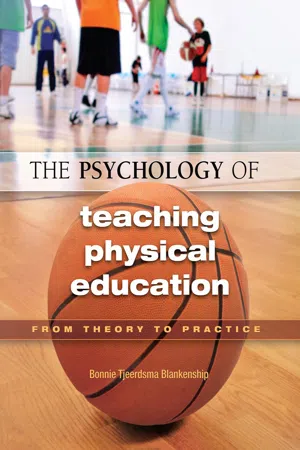![]()
CONTENTS
Preface
Acknowledgment
1 The Importance of Psychology to the Physical Educator
INTRODUCTION
WHAT IS THE PSYCHOLOGY OF TEACHING PHYSICAL EDUCATION?
WHY STUDY THE PSYCHOLOGY OF TEACHING PHYSICAL EDUCATION?
To Help Teachers Address Their Concerns
To Achieve Program Goals
To Establish a Positive Learning Environment
To Acquire Information and Applications
CHAPTER ORGANIZATION
Theory Explanation
Research Description
Practical Applications
STUDY TOOLS
Scenario
Focus Points
Connected Concepts
Key Concepts and Glossary
Application Exercises
SUMMARY
KEY CONCEPTS
2 Reinforcement
INTRODUCTION
REINFORCEMENT THEORIES
Behavioral Theory
Intrinsic Motivation and Extrinsic Rewards
Cognitive Evaluation Theory
REINFORCEMENT RESEARCH
Student Characteristics Related to the Use of Teacher Feedback
Reinforcement and Students’ Motor Skill Performance
Teacher Feedback and Student Self-Perceptions
Reinforcement, Behavior Management, and Prosocial Behaviors
Reinforcement, Behavior Management, and Physical Activity
Cognitive Evaluation Theory Research
PRACTICAL GUIDELINES FOR REINFORCEMENT IN PHYSICAL EDUCATION
Guidelines for Using Punishment
Guidelines for Giving Teacher Verbal Feedback
Guidelines for Giving Extrinsic Rewards
Example of the Effective Use of Extrinsic Rewards
Create a Behavior Management Program
Use the Personalized System of Instruction Model
SUMMARY
KEY CONCEPTS
APPLICATION EXERCISES
3 Modeling
INTRODUCTION
MODELING THEORIES
Social Learning Theory
Cognitive Mediation Theory
Learning from Observing a Model
MODELING RESEARCH
The Effectiveness of Modeling
Model Characteristics
Modeling Frequency and Timing
Use of Verbal Cues with Modeling
Rehearsal Strategies and Modeling
Auditory Modeling
EFFECTIVE MODELING IN PHYSICAL EDUCATION
Use a Variety of Models
Use Peer Coping Models
Explain That Perfection Is Not Required
Demonstrate Frequently
Repeat Verbal Cues During Demonstrations
Students Should Verbally Rehearse Cues
Give the Model Feedback During Demonstrations
Increase Motivation
Peer Teaching Instructional Model
Use Auditory Modeling with Temporal Tasks
Combine Reinforcement with Modeling to Enhance Prosocial Behaviors
SUMMARY
KEY CONCEPTS
APPLICATION EXERCISES
4 Moral Development
INTRODUCTION
DEFINING SPORTSPERSONSHIP AND MORAL REASONING
MORAL DEVELOPMENT THEORIES
Social Learning Theory
Structural Developmental Approaches
MORAL DEVELOPMENT RESEARCH
Age, Gender, and Moral Reasoning
Traditional Physical Education and Moral Development
Effectiveness of Social Learning and Structural Developmental Strategies
Instructional Models and Curricula Research
ENHANCING MORAL DEVELOPMENT IN PHYSICAL EDUCATION
Social Learning Strategies
Structural Developmental Strategies
Use an Instructional or Curricular Model That Addresses Prosocial Behaviors
SUMMARY
KEY CONCEPTS
APPLICATION EXERCISES
5 Achievement Goals
INTRODUCTION
PRINCIPLES OF ACHIEVEMENT GOAL THEORY
Goal Perspectives
Dispositional Goal Orientations
Motivational Climate
Approach and Avoidance Goals
ACHIEVEMENT GOAL RESEARCH
Manipulating the Motivational Climate
Changing Goal Orientations
Positive Affect
Student Behaviors
Self-Perceptions
Attributions
Beliefs About the Purpose of Physical Education
Participation in Physical Education
Student Perceptions of Teacher Behavior
Gender
Approach and Avoidance Goals in Physical Education
MEANS OF ENHANCING TASK INVOLVEMENT IN PHYSICAL EDUCATION
Use Stations
Use the Games Stages
Help Students Set Individual, Short-Term Goals
Use Alternative Assessments
Offer Students Choices
SUMMARY
KEY CONCEPTS
APPLICATION EXERCISES
6 Self-Perceptions
INTRODUCTION
SELF-PERCEPTION TERMS
SELF-PERCEPTION THEORIES
Competence Motivation Theory
Self-Efficacy Theory
SELF-PERCEPTIONS RESEARCH
Student Characteristics
Accuracy of Self-Perceptions
Sources of Competence Information
Psychological Factors Related to Self-Perceptions
Self-Perceptions and Motivated Behaviors
Self-Perceptions and Physical Activity Participation
Self-Perceptions and Instructional Models
MEANS OF ENHANCING SELF-PERCEPTIONS IN PHYSICAL EDUCATION
Help Students Experience Success
Teach Students to Use Imagery
Teach Students Arousal Regulation Techniques
Offer Students a Choice of Coed or Same-Sex Classes/Units
SUMMARY
KEY CONCEPTS
APPLICATION EXERCISES
7 Attributions
INTRODUCTION
ATTRIBUTION THEORY
Classifications of Attributions
Consequences of Attribution Classifications
Attributions and Motivation
The Attribution Process
The Developmental Nature of Attributions
LEARNED HELPLESSNESS
Pervasiveness and Permanence of Learned Helplessness
Mediators of Controllability
ATTRIBUTION RESEARCH
Student Characteristics
Consequences of Attribution Types
LEARNED HELPLESSNESS RESEARCH
Types of Attributions
Age
Task Persistence
Goal Orientations
ATTRIBUTION RETRAINING
TEACHER EXPECTATIONS RESEARCH
Performance Cues
Person Cues
Variables Affected by Teacher Expectations
Expectancy Process Reminders
PRACTICAL IMPLICATIONS FOR PHYSICAL EDUCATION
Become Aware of Students’ Attributions
Identify Learned Helpless Students
Conduct Attribution Retraining Sessions
Develop Accurate, Realistic, and
Monitor Your Attributions for Student Performance Outcomes
Make Adaptive Attributions for Student Performance Outcomes
Provide Equal Opportunities for Students
Create Leadership and Responsibility Roles for Students
Develop Realistic but Optimistic Expectations for Attribution Change
SUMMARY
KEY CONCEPTS
APPLICATION EXERCISES
8 Interest and Value
INTRODUCTION
TYPES OF INTEREST
Personal Interest
Situational Interest
VALUE
RESEARCH ON INTEREST AND VALUE
Relationships to Achievement and Performance
Relationships to Motivated Learning Behaviors and Intentions
Student Characteristics Related to Interest and Value
Sources of Subjective Task Value
Dimensions of Situational Interest
MEANS OF ENHANCING INTEREST IN AND VALUE FOR PHYSICAL EDUCATION
Personal versus Situational Interest
Meet Students’ Personal Interests
Catch Interest with Technology
Hold Interest with Personal Meaning
Offer Novel Activities
Challenge Students Cognitively
Arouse Students’ Intention to Explore
Use a Different Instructional Model
Create a Content Development
Use Teaching by Invitation and Intratask Variations
Diminish Gender-Role Stereotyping
SUMMARY
KEY CONCEPTS
APPLICATION EXERCISES
9 Motivation
INTRODUCTION
MOTIVATION DEFINED
SELF-DETERMINATION THEORY
Intrinsic Motivation
Extrinsic Motivation
Amotivation
Consequences of the Motivational Orientations
Role of the Social Context
The Motivational Process in Self-Determination Theory
MOTIVATION RESEARCH
Student Characteristics
Motivational Orientations and Consequences
Need Satisfaction and Motivation
Social Context
STRATEGIES TO INFLUENCE STUDENT MOTIVATION POSITIVELY IN PHYSICAL EDUCATION
Moving Students from Amotivation to Intrinsic Motivation
Reduce Students’ Body Image Concerns
Establish Strong Teacher-Student Relationships
Emphasize the Cooperation Within Competition
Promote an Incremental View of Ability
Establish a Structured Learning Environment
SUMMARY
KEY CONCEPTS
APPLICATION EXERCISES
10 Physical Activity and Lifestyle Enhancement
INTRODUCTION
THE YOUTH PHYSICAL ACTIVITY PROMOTION MODEL
Predisposing Factors
Reinforcing Factors
Enabling Factors
Personal Demographics
Designing Interventions
YOUTH PHYSICAL ACTIVITY RESEARCH
Does Early Participation Lead to Participation Later in Life?
Demographics
Predisposing Factors
Reinforcing Factors
Enabling Factors
The Impact of Physical Education on Physical Activity Levels
Other Interventions to Enhance Students’ Overall Physical Activity Levels
ENHANCING STUDENT PHYSICAL ACTIVITY LEVELS
Increase Physical Activity Levels During Physical Education Class
Emphasize Physical Activity over Physical Fitness
Teach Students Self-Management Skills
Inform Students About Physical Activity Opportunities Available Outside of School
Promote Peer Involvement
Ensure All Students Are Included
Identify Religious and Cultural Principles Related to Physical Activity
Model a Physically Active Lifestyle
Include Lifetime Physical Activities
Collaborate with Other School Staff
Increase Physical Activity Opportunities at School
Involve Parents/Caretakers and Other Family Members
Encourage Active Transport to School
SUMMARY
KEY CONCEPTS
APPLICATION EXERCISES
Appendix A
A.1 Survey to Determine Elementary Students’ Perceptions of Rewards
A.2 Form for Assessing Prosocial Behaviors in Physical Education
A.3 Scoring Sheet for a Daily Point System for Sport Education Units
A.4 Goal-Setting Sheet
A.5 Closed-Response Exit Slip
A.6 “Getting to Know You” Survey
A.7 “Reasons for Outcomes” Form
A.8 Unlimited-Choice Survey to Identify Students’ Personal Ac...

